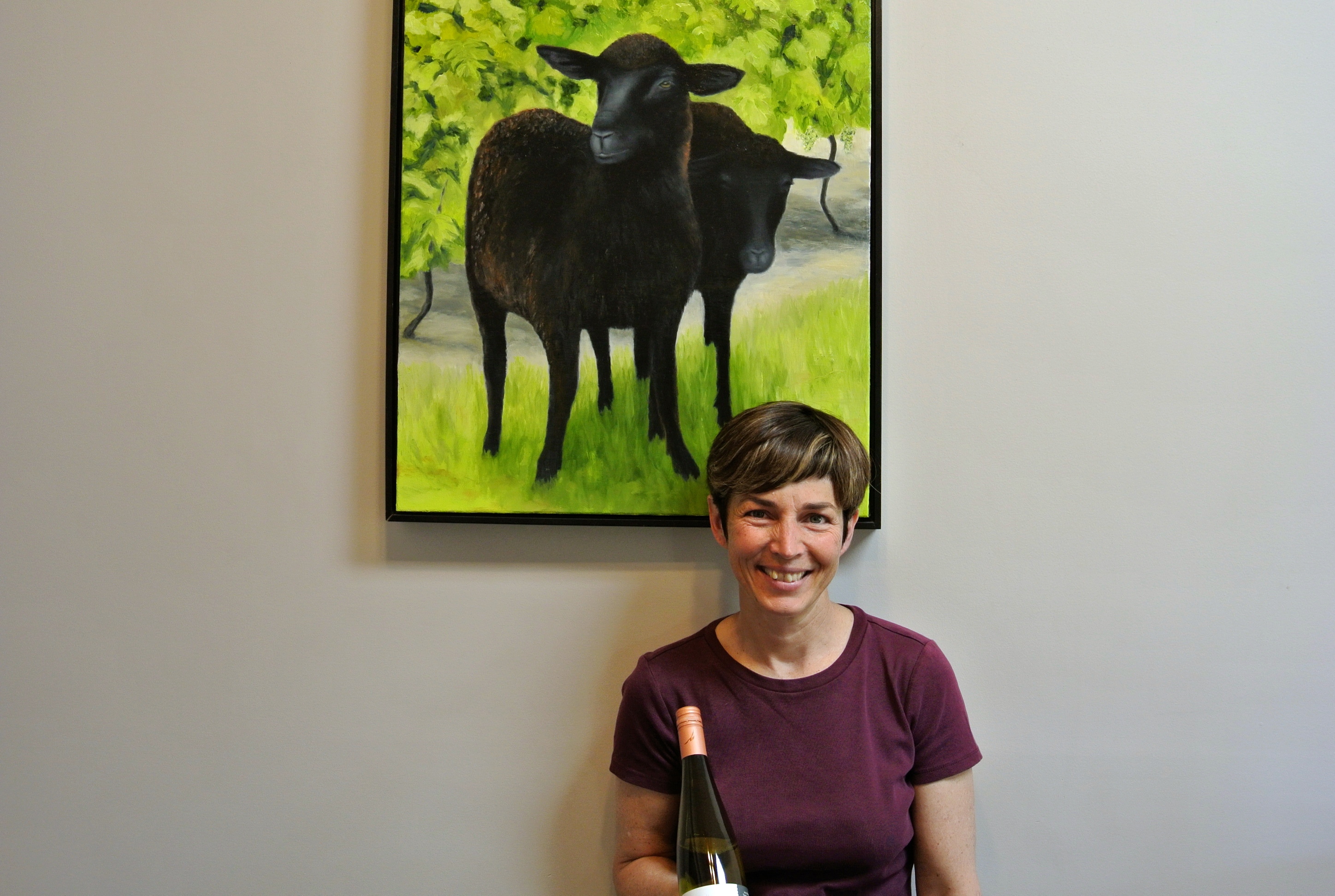
The picture hanging behind the tasting room bar at Featherstone Estate Winery in Vineland is a constant reminder of the four-legged work force that moves into the estate vineyard annually in the first week of July.
They work only for food in the pristine environment of David Johnson and Louise Engel’s farm-winery (Engel is pictured above). They live out their days until about mid-September getting happily fat on grape leaves until their work is done … and then they “go to market,” as Engels says ever so politely. “And that doesn’t mean shopping.”
Seems like a cruel end for such cute, hard-working creatures who give so much of themselves. But it’s farming and perhaps the most ultimate farm to table experience there is. The sheep keep the vines trimmed so sunlight can fatten the grapes, the sheep get fat on grape leaves, and come fall … well, you get the picture. Just add a bottle Featherstone Cabernet Franc and *boom* … dinner is served.
In order to produce premium grapes for winemaking, grape growers will remove the grape leaves in and around the “fruiting zone” where the grape clusters grow.
The increased exposure to the sun helps the grapes to produce more of the flavour compounds that are important to wine quality. As well, removing grape leaves in this area allows the morning dew on the grapes to dry more quickly, with the result that harmful moulds are less likely to develop.
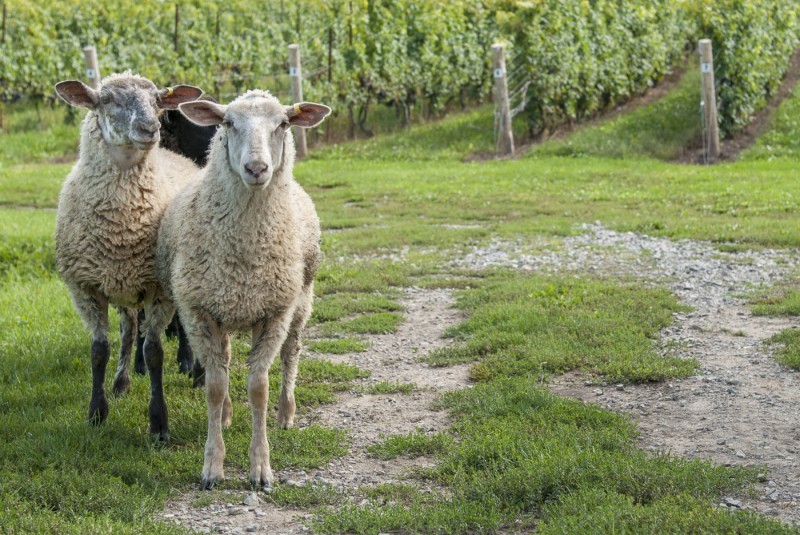
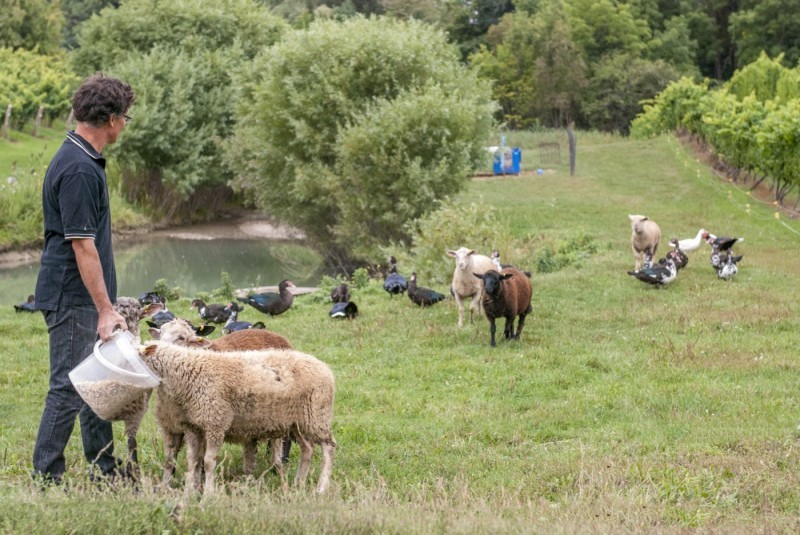
Traditionally, the leaves in the fruiting zone are painstakingly removed by hand (or sometimes, using specialized machinery).
In 2007, Johnson spent eight weeks in New Zealand, where the use of sheep in vineyards is commonplace. Sheep like to eat — and the tender young grape leaves are very appealing to them. He then pioneered the use of sheep in Niagara after sourcing the animals from Penny and Andrew Oliver of Willow Haven Farm in nearby St. Ann’s, Ontario.
“Sheep are ideally suited to the job,” Johnson says. “They can’t reach very high and aren’t interested in eating the tart, unripe grapes. Using sheep to thin grape leaves is a holistic approach that appeals to us a lot. And of course, there’s the added bonus that they fertilize as they move through the vineyard. The ‘ecological hoofprint’ is quite small.”
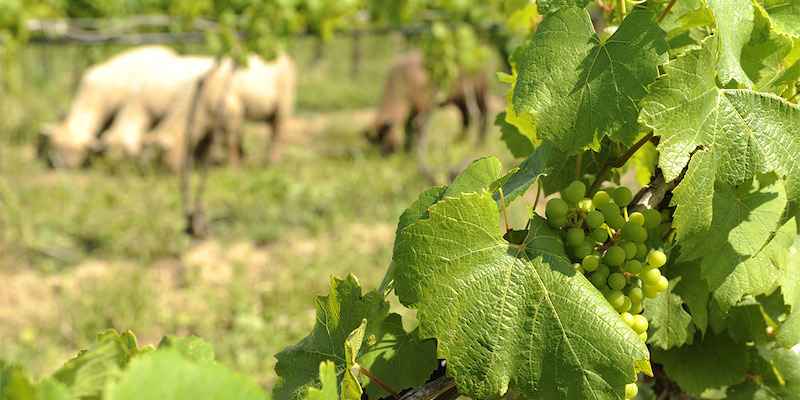
The sheep labour is in keeping with other ecologically sensitive practices at Featherstone. The vineyards are kept insecticide-free, and the farm also uses birds of prey to control nuisance starlings and pest birds that eat the grapes in the fall.
It’s only fitting that Featherstone named its most popular wine after the animals, the Featherstone Black Sheep Riesling.
I sat down recently with Engels to taste through the new releases at Featherstone. Here’s what I can recommend.
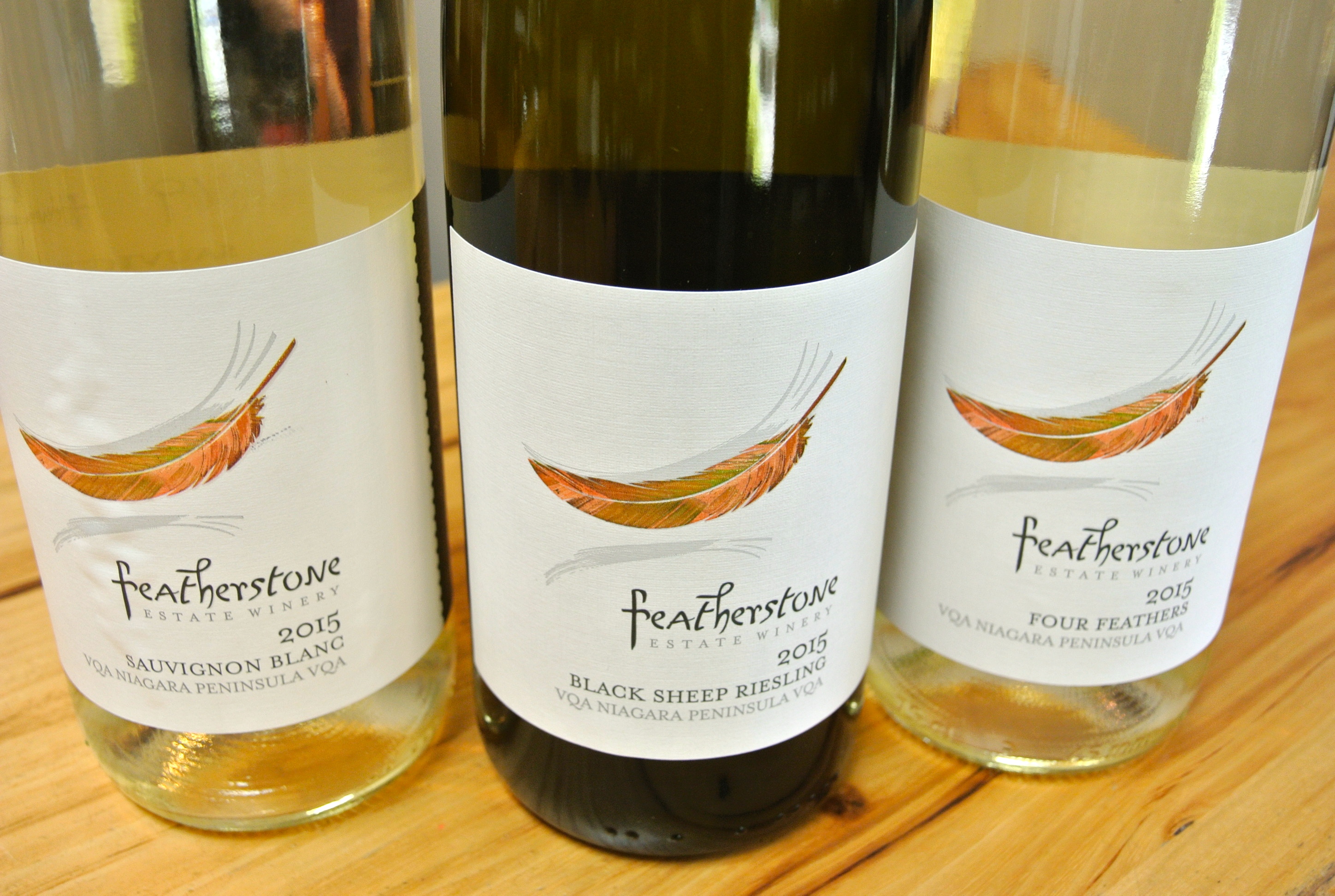
Featherstone Black Sheep Riesling 2015 ($17, winery, Vintages in August, 91 points) — This is the “signature” white wine made at the farm. Out of a 6,000-7,000 case production, up 2,800 cases are Riesling, so “this is a big deal for us,” says Engels. “We could make Riesling all day long. It is simplicity at its best.” Featherstone’s Riesling has always maintained a style that is consistent vintage to vintage with alcohol below 10%. The nose shows a bright profile of lime, grapefruit, sherbet and apple in a fresh and vibrant style. It is light and refreshing on the palate with a playful tug of sweet and tart citrus and orchard fruit on the palate. Lovely balance and clean through the finish.
Featherstone Sauvignon Blanc 2015 ($18, winery, Vintages, 88 points) — An herbaceous nose with some grassy notes to go with grapefruit, citrus and tropical fruits. The palate shows a range of tropical fruits, melon, grapefruit and herbs in a refreshing style.
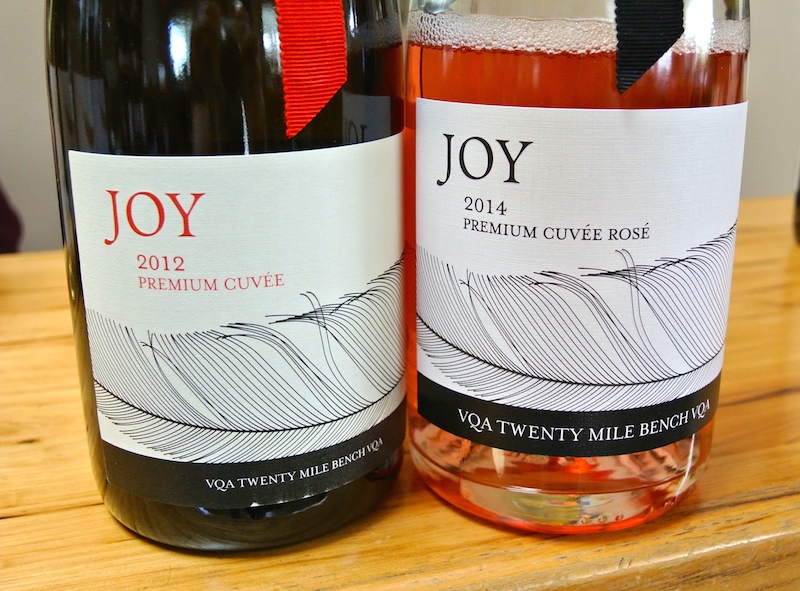
Featherstone Cuvée Joy 2012 ($35, winery, Vintages in December, 92 points) — A traditionally-made, 100% estate Chardonnay sparkling wine that lives up to its name — pure joy. The nose shows a balanced melange of pear, citrus, fresh baked bread and yeasty-toasty notes. It’s fresh and lively on the palate with a persistent bubble that highlights the pear, lime and lemon fruits that are bursting with flavour and vitality. This is a bubbly that is en pointe, with poise, balance and razor sharp acidity.
Featherstone Cuvée Joy Rosé 2014 ($30, winery, Vintages in March, 91 points) — The success of the Joy sparkling wine has prompted the decision by Featherstone to turn their single acre of Pinot Noir into a sparkling wine and discontinue the Pinot Noir table bottling as of the 2014 vintage. This first “pink” sparkler is finished with a touch more sweetness than the regular Joy but also shows more fruit. The nose displays notes of cherry, cranberry, raspberry and violets. On the palate look for pretty red fruits, a vigorous mousse and a balanced, perkiness through the finish.
Featherstone Canadian Oak Chardonnay 2014 ($22, winery, Vintages in December, 89 points) — Can’t really make a wine more “Canadian” than this. The oak comes from Brantford, the Chardonnay is all estate fruit and once the grapes are picked and pressed, the juice goes to barrel where it wild ferments in the vineyard and is aged in the Canadian oak barrels. The nose shows a rich broth of orchard fruits, oak spices, toasted vanilla and caramel. On the palate an array of pear and apple fruit is joined by buttery/spicy notes in a generous and rich style.
Featherstone Rose 2015 ($16, winery, Vintages, 88 points) — Made from a quartet of red grapes with at least half the fruit Cabernet Franc. The nose is bold with rich red fruits in a bright and cheerful style. It’s made with just a touch of sweetness and shows a basket of red fruits that are ripe and sassy.
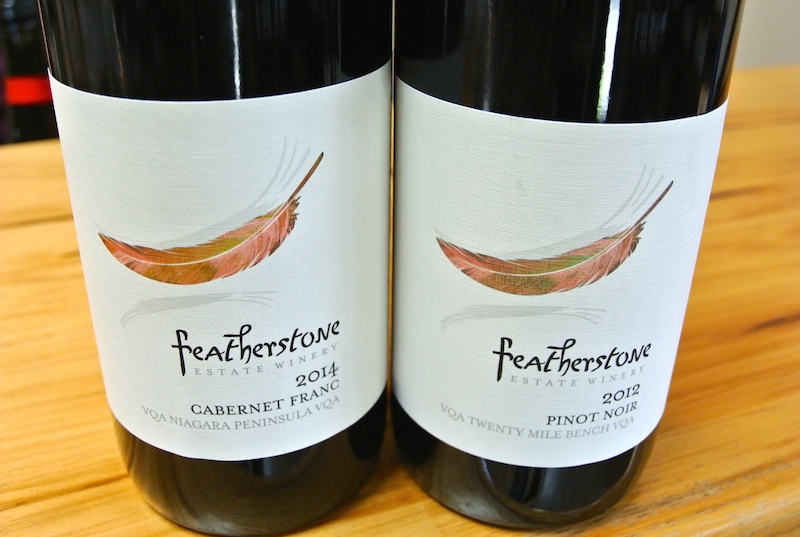
Featherstone Pinot Noir 2012 ($25, winery, 88 points) — Enjoy this while it lasts; subsequent vintages of the Pinot are being directed into the new sparkling rose. It’s a pretty and perfumed Pinot with bright cherry and strawberry notes with a touch of spice. A touch of cassis mingles with red fruits, earth and spicy. Gulping Pinot, very approachable now.
Featherstone Cabernet Franc 2014 ($19, winery, Vintages Essentials, 88 points) — A delightful and priced-right CF with a nose of wild raspberry, black cherry, herbs, earth and spice. On the palate all those red fruits and spice are bolstered by medium-plus tannins and refreshing acidity.
Featherstone Four Feathers 2015 (previously reviewed, winery, LCBO/Vintages June and September, $15, 87 points) — An estate white blend that’s based on 50% Riesling. The nose shows lime, grapefruit, lychee, lemon and fresh-cut hay notes. It’s an easy-to-drink backyard with that’s made slightly off-dry with loads of tropical and citrus fruits on the palate.





Comment here